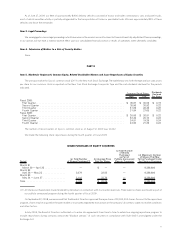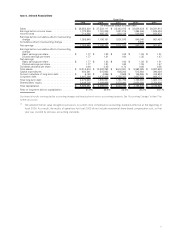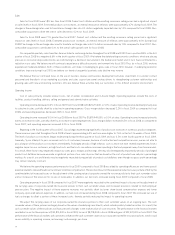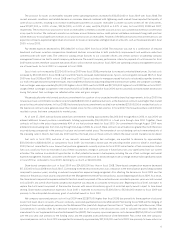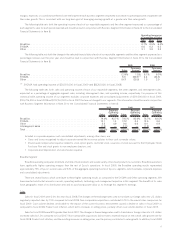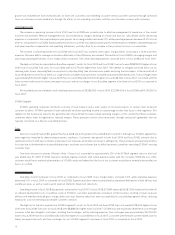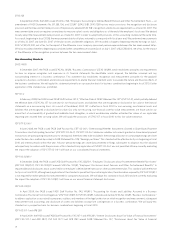Sysco 2009 Annual Report Download - page 39
Download and view the complete annual report
Please find page 39 of the 2009 Sysco annual report below. You can navigate through the pages in the report by either clicking on the pages listed below, or by using the keyword search tool below to find specific information within the annual report.Other Segment
“Other” financial information is attributable to our other operating segments, including our specialty produce, custom-cut meat and lodging
industry products and a company that distributes to international customers.These operating segments are discussed on an aggregate basis as they
do not represent reportable segments under segment accounting literature.
On an aggregate basis, our “Other” segment has had a lower operating income as a percentage of sales than Sysco’s Broadline segment. Sysco
has acquired the operating companies within these segments in relatively recent years. These operations generally operate in a niche within the
foodservice industry. These operations are also generally smaller in sales and scope than an average Broadline operation and each of these segments
is considerably smaller in sales and overall scope than the Broadline segment. In fiscal 2009, in the aggregate, the “Other” segment represented
approximately 8.8% of Sysco’s overall sales and 4.9% of the aggregate operating income of Sysco’s segments, which excludes corporate expenses
and consolidated adjustments.
Operating income decreased 25.8% for fiscal 2009 over fiscal 2008. The decrease in operating income was caused primarily by reduced sales
in all segments attributable to the deteriorating economic environment.
Operating income increased 3.0% for fiscal 2008 over fiscal 2007. The increase in operating income was generated primarily by improved
results in the specialty produce and the lodging industry segments offset by reduced sales and operating income in the custom-cut meat segment.
Liquidity and Capital Resources
Sysco’s strategic objectives require continuing investment. Our resources include cash provided by operations and access to capital from
financial markets. Our operations historically have produced significant cash flow. Cash generated from operations is first allocated to working
capital requirements; investments in facilities, systems, fleet and other equipment; cash dividends; and acquisitions compatible with our overall
growth strategy. In addition, this cash will be used to satisfy the requirements of the IRS settlement over the next three years. Any remaining cash
generated from operations may be invested in high-quality, short-term instruments or applied toward a portion of the cost of the share repurchase
program. As a part of our on-going strategic analysis, we regularly evaluate business opportunities, including potential acquisitions and sales of
assets and businesses, and our overall capital structure. These transactions may materially impact our liquidity, borrowing capacity, leverage ratios
and capital availability.
We believe that our cash flows from operations, the availability of additional capital under our existing commercial paper programs and bank
lines of credit and our ability to access capital from financial markets in the future, including issuances of debt securities under our shelf registration
statement filed with the Securities and Exchange Commission (SEC), will be sufficient to meet our anticipated cash requirements over at least the
next twelve months, while maintaining sufficient liquidity for normal operating purposes. During the recent tightening of the credit markets, we have
continued to maintain the highest credit rating available for commercial paper. We believe that we will continue to be able to access the commercial
paper market effectively. We also issued long-term senior notes totaling $500,000,000 under our shelf registration statement during the third
quarter of fiscal 2009 in order to take advantage of the interest rates available to us at that time and to enhance our liquidity position. We believe that
we will continue to be able to access the long-term capital market effectively.
Operating Activities
We generated $1,582,341,000 in cash flow from operations in fiscal 2009, $1,596,129,000 in fiscal 2008 and $1,402,922,000 in fiscal 2007.
Cash flow from operations in fiscal 2009 was primarily due to net income, reduced by decreases in accounts payable balances and accrued
expenses, offset by decreases in accounts receivable balances and inventory balances and an increase in accrued income taxes. Cash flow from
operations in fiscal 2008 was primarily due to net income, reduced by decreases in accrued income taxes and increases in accounts receivable
balances and inventory balances, partially offset by a decrease in prepaid expenses and other current assets. Cash flow from operations in fiscal
2007 was primarily due to net income, reduced by decreases in accrued income taxes and increases in accounts receivable balances, inventory
balances and prepaid expenses and other current assets, partially offset by increases in accrued expenses and accounts payable balances.
The decrease in accounts receivable and inventory balances in fiscal 2009 was primarily due to the sales decline. The increases in accounts
receivable and inventory balances in fiscal 2008 and fiscal 2007 were primarily due to sales growth. The decrease in accounts payable balances in
fiscal 2009 was primarily from inventory decreases resulting from the sales decline.The increases in accounts payable balances in fiscal 2008 and
fiscal 2007 were primarily due to inventory increases resulting from sales growth. Accounts payable balances are impacted by many factors,
including changes in product mix, cash discount terms and changes in payment terms with vendors.
Cash flow from operations was negatively impacted by decreases in accrued expenses of $120,314,000 during fiscal 2009 and $22,721,000
during fiscal 2008 and positively impacted by an increase in accrued expenses of $132,936,000 during fiscal 2007. The decrease in accrued
expenses during fiscal 2009 was primarily due to the payment of prior year annual incentive bonuses, offset by lower accruals for current year
incentive bonuses. The decrease in accrued expenses during fiscal 2008 was primarily due to the reversal of a product liability claim which is further
explained below. This decrease was partially offset by increased accrued interest due to fixed-rate debt issued in fiscal 2008 and an increase to a
provision related to a multi-employer pension plan. See additional discussion of multi-employer pension plans at “Liquidity and Capital Resources,
Other Considerations.” The increase in accrued expenses during fiscal 2007 was primarily due to increased accruals for fiscal 2007 incentive
bonuses due to improved operating results over fiscal 2006.
19


